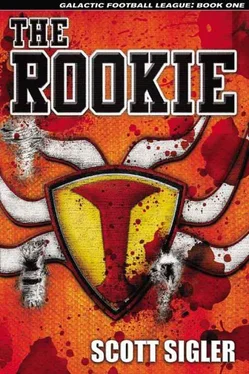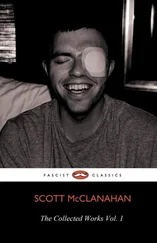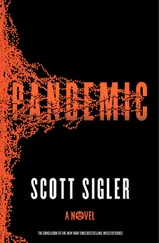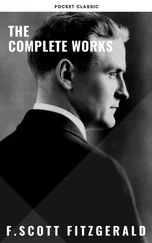After second meal, he studied some more. When most of the team went to sleep, Quentin set up shop in the VR field. By the third day, every Sklorno on the team was showing up for the late night sessions: Quentin practiced with three or four receivers, depending on the set, and a full compliment of defensive backs. The extra reps proved invaluable, and his timing started to improve, but it was the defenders that really got him over the hump. He could run whatever play he wanted, as many times as he wanted, gradually building up an instinctive knowledge of how fast the defenders could break on the ball, and how far away they had to be to constitute an “open” receiver.
And he made sure they came at him with plenty of safety and corner blitzes.
It would be a long time before Sklorno-level speed became second-nature to him, the way Human-level speed had been back on Micovi. But as he ran rep after rep, threw pass after pass, he regained the belief that he could handle the offense and throw with total confidence.
• • •
QUENTIN HAD ASSUMED that no construct could be larger than Emperor One.
He was wrong.
Orbital Station Two, or “The Deuce” as it was known across most of the Human worlds, reminded Quentin of an animal he’d seen in his science classes: the sea urchin. The Deuce was spherical, like a moon or a planet, with hundreds of massive, orderly, hollow blue spires jutting up and away from the surface.
He looked around the Touchback’s viewing bay. All of the rookies were there, of course, as they were to see any new planet. All of the Quyth Warriors were present, as was Hokor and at least two dozen Quyth Workers. Quentin hadn’t even known that many Quyth Workers were on the ship. All of them — Warriors, Leaders and Workers alike — stared at the viewscreen with a suffused reverence.
He looked for someone to talk to. Every minute of every day, he tried to find any opportunity to communicate with his teammates, to forge the bonds that Pine said were so critical to winning. He realized he’d spent absolutely no time with Quyth Warriors. He walked across the viewing deck to stand next to Virak the Mean.
“Just how big are those things,” Quentin asked, gesturing to the urchin-spikes that jutted from the space station.
Virak turned and looked at him. A Quyth Leader’s eye is a huge, glassy sphere that looks about as resilient as a Giving Day tree ornament. A Quyth Warrior’s eye, on the other hand, stares out from beneath thick, bony ridges. Even though a Warrior is more than twice the size of a Leader, a Warrior’s eye is about two-thirds the size of a Leader’s. A heavy eyelid, thick as Mason leather and coated with overlapping scales of tough chitin, hooded Virak’s eye from the top. Quentin’s childhood combat training taught him that the eye was the best place to attack a Quyth Warrior, but combat sims with realistic robots were a long way away from facing one in being-to-being combat. Now that he’d seen Quyth Warriors move in person, and on the field, the idea of poking out a Quyth Warrior’s baseball-sized eye seemed much easier said than done.
Virak looked at him with a combination of amusement and disdain. Of all the races, the Quyth seemed to share the most Human-like emotions. When Virak spoke, it was with an air of boredom. “They are about two miles long.”
“Two miles? That’s amazing, they look so thick to be that tall.”
“The spikes are about an eighth of a mile thick. They are beautiful.”
Quentin stared at them, and nodded. The symmetrical placement of the spikes did give the space station an ironically delicate appearance.
“The spikes are a life form,” Virak said. “A silica-based organism that grows in a dense crystalline matrix. They are like bacteria. They grow, feed, and reproduce in numbers beyond comprehension. Only the outside of the spike is alive — the inside is nothing but dead skeletons, but it is incredibly dense and hard. The crystalline structure gives it the strength to reach such massive heights.”
“What are they for?”
“They serve two purposes. They reach down to the core. We can vent energy through them to propel the station in any direction. They are also the main supports of the Deuce’s framework. Crossbeams connect to the spikes. You can see one below the equator, there.”
Virak pointed. Quentin saw another long, green structure, although this one was horizontal rather than vertical. It ran between two spikes.
“Why is there only that one crossbeam?”
“There are thousands of them, but they are buried,” Virak said. “The Deuce is built in stages, and each stage takes several cycles. With that crossbeam in place, workers will add to the station’s mass.”
As Quentin watched, a small, speckle-coated asteroid drifted down below the spike points and towards the surface. It took his brain a second to register the scale involved — the speckles were actually ships, and the asteroid had to be at least ten miles across and five miles thick. As he watched, the speckle-ships (which were each probably larger than the Touchback ) drove the asteroid down. About a half-mile from the surface, the speckle-ships broke off, flying away from the asteroid like a slow-moving cloud of gnats. The massive rock continued its descent until it smashed into the surface with a huge, billowing cloud of dust and debris. The cloud seemed to hang in the air, floating lightly, pulled back down ever-so-slowly by The Deuce’s weak gravity.
“That is how it gets bigger,” Virak said. “Every day ships go out and find asteroids. They bring them back to add to the surface. As the mass continues to grow, so does the gravity, and so does the density of the Deuce’s core. Additional matter on the surface compresses the core. The original living levels have long since been smashed flat by gravity. Workers constantly dig new levels creating an exponentially increasing living area to accommodate a high birth rate. Immigration to the Orbital Stations fell to a near standstill after Whitok and Ionath were colonized. Now those seeking to escape the overpopulation of Quyth head to those planets instead of the Orbital Stations.”
Quentin stared at the asteroid, a small pebble in a slightly larger crater. Crater and asteroid both barely a pimple on the surface.
“How long does it take to bring the asteroids in?”
Virak thought for a moment. “It depends on the materials needed. Some trips take only a few months. Others seek out asteroids comprised of rare or vital minerals, such as platinum or iridium. Those missions can take hundreds of years. It is common for a crew to leave The Deuce knowing that they will be long dead of old age before the ship returns, and their children or grandchildren will pilot the vessel home.”
“How many ships are there?”
“Somewhere around a hundred thousand.”
“A hundred… just how long does it take to build that thing out there?”
“The Deuce has been growing for almost three hundred years, and The Ace is just over three hundred and fifty years old.”
Quentin shook his head in amazement. All his life he’d been told the Quyth were only semi-intelligent beasts. Yet here was an engineering project that rivaled the terraforming of Solomon, a race so unified in purpose that they sacrificed themselves to build a home for future generations.
“It’s not that big,” Quentin said. “I mean, for an artificial construct, it’s massive. But from a strategic perspective, I can’t see how the Creterakians could take over entire planets that were twenty times as large, but not be able to take The Deuce.”
“They took over other planets by swarming across the surface and overwhelming the enemy by sheer numbers,” Virak said. “Here, the surface doesn’t support life. They had to fight their way into the shaft to get at the living levels. They tried the same technique they used against the big ships — launching thousands of landing vessels, trying to overwhelm our shaft defenses. We slaughtered their people by the millions.”
Читать дальше












